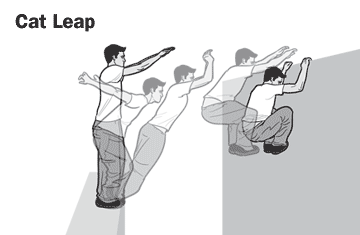
In single-file formation and with remarkable economy of movement, half a dozen men bound up the face of a six-foot wall, leap into the exposed gap of a stairwell, then reappear two stories higher perched on the thin ledge of a terrace. After jumping to another balcony several feet away, they vault the side rail and lower themselves to the veranda below where they hang from the edge for a few moments. Then, one by one they drop 10 feet (3 m) to the ground, collapsing into tightly wound balls and rolling away before popping up to scale the face of another structure several yards away. The entire circuit takes fewer than 30 seconds to complete and comprises just one leg in a nearly hour-long session of the spectacular urban adventure known as parkour — where the destination, to steal a phrase, is the journey.
A blend of adapted gymnastics, athletics, free climbing and accelerated tai-chi movements executed on the move, parkour is attracting a growing number of adepts across its birthplace France and around the world by providing remarkable physical and mental training — as well as an amazing spectacle to behold. And it does that in places most people consider anything but a playground: the very urban settings, city structures and office complexes that half the planet lives and works in every day. "Parkour turns the city into nature for me by transforming a building into a mountain and a wall into a tree," says David Belle, the creator and best-known practitioner of parkour. "It's a form of expression through movement amid obstacles that aren't supposed to be overcome."
The sight of people vaulting imposing obstructions or plunging bone-rattling distances can be spectacular — a major reason for the abundance of Internet videos of parkour enthusiasts (or "traceurs," in their lingo) leaping between vertiginous rooftops, or executing flips or twists while rappelling off walls. But while that may look snazzy, hard-core traceurs say most razzle-dazzle misses the point of the discipline, which they describe as exploring the capabilities of one's body, the better to react in extreme, even urgent situations. Belle based parkour on the multidiscipline training his fireman father devised to help himself and his colleagues deal with emergency conditions. "The objective of parkour is to make yourself strong in order to be useful," says David's brother, Jean-François, an official in France's military fire-fighting forces.
It is also a form of transport, both metaphoric and practical. "Real parkour is about going from point A to B as fast, efficiently and safely as possible, which is why you repeat all the moves, jumps and falls a million times in controlled situations before you try anything more challenging," says 18-year-old Thomas Mougne, a traceur from suburban Paris. "The guys in the videos are doing flashy stuff because that's the point of the video: to be seen. Parkour is more about being here and gone as quickly as possible." Mougne's parkour partner, Seyf Boubakeur, says he used to be undisciplined and showy — bouncing off walls and taking heart-stopping risks. But regular training and a focus on the efficiency beloved by parkour purists, Boubakeur says, have taught him that limitations must first be conquered in his own head. "It's liberating to learn how to do something I initially discovered I couldn't do, rather than just attacking it blindly as I would have before, often failing," says Boubakeur, 20, an architecture student.
That combination of physical and mental elements is the real appeal of parkour to true devotees. "Parkour takes you to places and across boundaries you didn't think you could cross before," says Paris area traceur Erwan Suquet, 22. "The key is to prepare and endure." And ultimately to test the limits of mind and body.